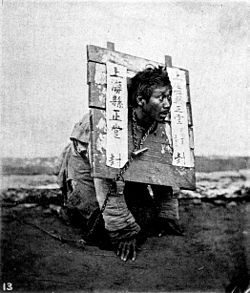This is an old revision of this page, as edited by 維基小霸王 (talk | contribs) at 00:30, 26 June 2020 (higher resolution). The present address (URL) is a permanent link to this revision, which may differ significantly from the current revision.
Revision as of 00:30, 26 June 2020 by 維基小霸王 (talk | contribs) (higher resolution)(diff) ← Previous revision | Latest revision (diff) | Newer revision → (diff)| Cangue | |||||||||||||||
|---|---|---|---|---|---|---|---|---|---|---|---|---|---|---|---|
 A man in a cangue in Shanghai, photographed by John Thomson c. 1870. The label reads “上海縣正堂,封” meaning sealed by the Shanghai County Magistrate. The offender had to rely on passersby for food. A man in a cangue in Shanghai, photographed by John Thomson c. 1870. The label reads “上海縣正堂,封” meaning sealed by the Shanghai County Magistrate. The offender had to rely on passersby for food. | |||||||||||||||
| Classical Chinese | |||||||||||||||
| Chinese | 枷 | ||||||||||||||
| |||||||||||||||
| Modern Chinese | |||||||||||||||
| Chinese | 木枷 | ||||||||||||||
| |||||||||||||||
| Third alternative Chinese name | |||||||||||||||
| Chinese | 枷鎖 | ||||||||||||||
| |||||||||||||||

A cangue (/kæŋ/) or tcha is a device that was used for public humiliation and corporal punishment in East Asia and some other parts of Southeast Asia until the early years of the twentieth century. It was also occasionally used for or during torture. Because it restricted a person's movements, it was common for people wearing cangues to starve to death as they were unable to feed themselves.
The word "cangue" is French, from the Portuguese "canga," which means yoke, the carrying tool has also been used to the same effect, with the hands tied to each arm of the yoke. Frequently translated as pillory, it was similar to that European punishment except that the movement of the prisoner's hands was not as rigorously restricted and that the board of the cangue was not fixed to a base and had to be carried around by the prisoner.
Forms
Although there are many different forms, a typical cangue would consist of a large, heavy flat board with a hole in the center large enough for a person's neck. The board consisted of two pieces. These pieces were closed around a prisoner's neck, and then fastened shut along the edges by locks or hinges. The opening in the center was large enough for the prisoner to breathe and eat, but not large enough for a head to slip through. The prisoner was confined in the cangue for a period of time as a punishment. The size and especially weight were varied as a measure of severity of the punishment. The Great Ming Legal Code (大明律) published in 1397 specified that a cangue should be made from seasoned wood and weigh 25, 20 or 15 jīn (roughly 20–33 lb or 9–15 kg) depending on the nature of the crime involved. Often the cangue was large enough that the prisoner required assistance to eat or drink, as his hands could not reach his own mouth.
Cage

The cangue would be placed atop a cage, such that the prisoners feet could not quite touch the ground. supports would be placed under the feet initially, so that he would stand without pressure on the neck. gradually, the supports would be removed, forcing the cangue to slowly hang him.
References
- ^ Jamyang Norbu, From Darkness to Dawn, site Phayul.com, May 19, 2009.
- Chisholm, Hugh, ed. (1911). "Cangue" . Encyclopædia Britannica (11th ed.). Cambridge University Press.